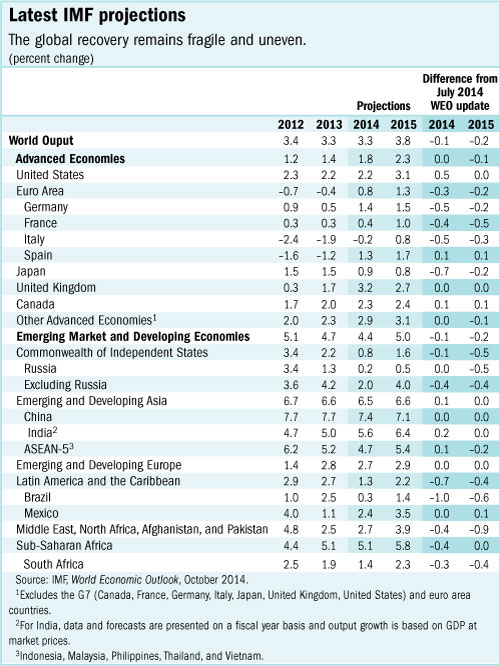
Typical street scene in Santa Ana, El Salvador. (Photo: iStock)
IMF Survey : Global Growth Disappoints, Pace of Recovery Uneven and Country-Specific
October 7, 2014
- Global growth at 3.3 percent in 2014 and 3.8 percent in 2015; forecasts shaved down since April
- Legacies from crisis, low potential growth weigh on recovery
- Increased downside risks to global growth, including financial and geopolitical
A weak and uneven global economic recovery continues, but reflecting different evolutions across various countries and regions, says the IMF’s latest World Economic Outlook (WEO).

A worker unloads coal from truck inside a coal yard in Gujarat, India. Structural reforms, such as in the power sector in India, are needed to unlock growth (photo: AMIT DAVE/Reuters/Corbis)
WORLD ECONOMIC OUTLOOK
The IMF forecasts global growth to average 3.3 percent in 2014―unchanged from 2013―and to rise to 3.8 percent in 2015. The weaker than expected growth outlook for 2014 reflects setbacks to economic activity in the advanced economies during the first half of 2014, and a less optimistic outlook for several emerging market economies, says the report.
Potential growth rates—that is, the pace at which annual output can expand without pushing up inflation—are also being revised down. “These worse prospects are in turn affecting confidence, demand, and growth today,” says Olivier Blanchard, Economic Counsellor and head of the IMF’s Research Department.
Two underlying forces weigh on global recovery, according to Blanchard. “In advanced economies, the legacies of the precrisis boom and the subsequent recession, notably high debt burdens and unemployment, still cast a shadow on the recovery, and low potential growth ahead is a concern.” Several emerging markets are also adjusting to lower potential growth.
Across the globe, investment has been weaker than expected for some time. As a result, “global growth is still mediocre,” says Blanchard.
At the same time, Blanchard notes, economic evolution is becoming more differentiated in major countries and regions, with the pace of recovery reflecting various country-specific conditions.
Growth prospects vary in advanced economies
In advanced economies, growth is forecast to rise to 1.8 percent in 2014 and 2.3 percent in 2015.
Much of the projected strengthening in activity reflects faster growth in the United States following a temporary setback in the first quarter of this year. Employment growth has been strong, and household balance sheets have improved amid favorable financial conditions and a recovering housing market.
In the euro area, recent growth disappointments highlight lingering fragilities. A gradual, but weak recovery is projected to take hold, supported by a sharp compression in interest spreads for stressed economies and record-low long-term interest rates in core euro area economies.
In Japan, GDP contracted more than expected in the second quarter of 2014 in the wake of an increase in the consumption tax. Looking ahead, private investment is forecast to recover and growth to remain broadly stable in 2015.
Emerging markets are adjusting to slower growth
Growth in emerging market and developing economies will continue to account for the lion’s share of global growth. Still, at 4.4 percent for 2014, the growth forecast is a bit weaker than in the April 2014 WEO. This slowdown is due to lackluster domestic demand and the impact of increasing geopolitical tensions, especially on Russia and neighboring countries.
• In China, growth is expected to decline slightly in 2014-15 to 7.4 percent, as the economy transitions to a more sustainable path. Growth is expected to remain strong elsewhere in emerging and developing Asia.
• In Latin America, the growth rate is forecast to decrease by half this year, to around 1.3 percent, due to declining exports as well as domestic constraints. Growth is expected to rebound to around 2.2 percent in 2015.
• In sub-Saharan Africa, stronger growth is expected because of supportive external demand conditions and strong investment demand, although prospects vary across countries.
• In the Middle East and North Africa, the recovery remains fragile even as growth is expected to start picking up modestly on the back of improving domestic security conditions and improving external demand. Similar considerations underpin modest improvements in activity in Russia and other economies of the Commonwealth of Independent States.

Considerable downside risks
The October WEO emphasizes the increase in downside risks—both in the short and medium term—that could dent global confidence and growth.
• Heightened geopolitical risks could prove more persistent, and they could also worsen. The result could be sharply higher fuel prices, trade disruptions, and further economic distress.
• Easy financial conditions, and the resulting search for yield, could fuel financial excess. Markets may have underpriced risks by not fully internalizing the uncertainties around the global outlook. A larger-than-expected increase in U.S. long-term interest rates, geopolitical events, or major growth disappointments could trigger widespread disruption.
• In advanced economies, secular stagnation (a situation of a persistent shortfall of investment relative to saving, even with near-zero interest rates) and low potential growth continue to be important medium-term risks—despite continued very low interest rates and increased risk appetite in financial markets. Protracted low inflation or outright deflation, particularly in the euro area, could pose a risk to activity and debt sustainability in some countries.
Raising potential
In the face of weaker-than-expected global growth for the first half of 2014 and increased downside risks, growth may again fail to pick up or may fall short of expectations. This underscores that, in most economies across the globe, raising actual and potential output must remain a priority, the IMF says.
In advanced economies, there remains a need to avoid prematurely normalizing monetary policy. Fiscal adjustment must be tuned in both pace and composition to support the recovery and lay the groundwork for long-term growth and jobs. In this context, an increase in public infrastructure investment could provide a boost to demand in the short term and help raise potential output in the medium term in those countries with clearly identified infrastructure gaps (such as structure maintenance/upgrading in United States and Germany) and efficient public investment processes.
The scope for emerging market economies to use macroeconomic policies to support growth varies and is more limited in countries with external vulnerabilities. At the same time, emerging markets will need to deal with monetary policy normalization in the United States and possible shifts in financial market sentiment.
For both advanced and emerging market countries, there is a general, urgent need for country-specific structural reforms to strengthen potential growth or make growth more sustainable. For many countries, this means improving labor and product markets, including reforms to lower the costs of hiring on regular employment contracts and facilitating greater labor force participation (many advanced European economies and Japan), and easing barriers to doing business and investment in the services.
“The challenge for both advanced and emerging market economies, is to go beyond the general mantra of ‘structural reforms,’ to identify which reforms are most needed, which reforms are politically feasible,” says Blanchard.
More generally, Blanchard adds, policymakers need to “reestablish confidence through clear plans to deal with both the legacies of the crisis and the challenge of low potential growth.”


